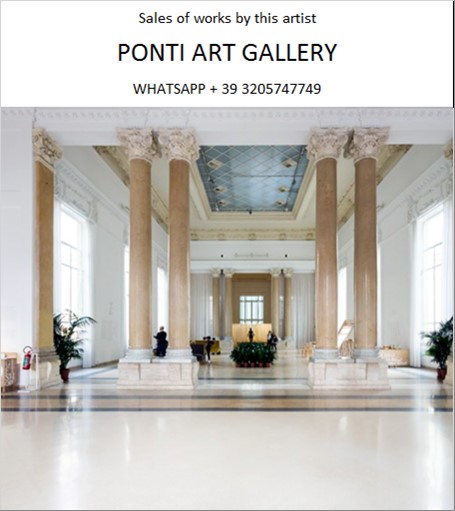Ponti Art Gallery is interested in buying and selling works
of art by this artist.

Maestro Leoncillo Biography
Leoncillo Leonardi, known simply as Leoncillo, was an Italian sculptor whose innovative work with glazed ceramics marked him as one of the most significant European sculptors of the post-war period. Born on November 18, 1915, in Spoleto, Umbria, Italy, Leoncillo's early life was steeped in the rich artistic traditions of his homeland. His father, a drawing teacher, and his grandfathers, a cabinet-maker and a musical instrument maker, undoubtedly influenced his creative path.
Leoncillo's artistic journey began at the Istituto d'Arte of Perugia, where he studied from 1931 to 1935. His initial works were portraits influenced by Medardo Rosso's style, but it was in Rome, where he moved in 1935, that his artistic identity began to take shape. In Rome, he taught drawing and studied at the Accademia di Belle Arti di Roma under Angelo Zanelli. During this time, he became associated with the Scuola Romana, meeting artists such as Mario Mafai, Antonietta Raphael, Afro and Mirko Basaldella, and Marino Mazzacurati.
In 1939, Leoncillo married Maria Zampa, a fellow art student, and soon after, he managed the Ceramiche Rometti pottery works in Umbertide. This experience was crucial in honing his skills in ceramics. His early masterpieces, such as the Harpy, the Mermaid, and the Hermaphrodite, showcased a grotesque expressionism influenced by the painter Scipione.
Leoncillo's career was interrupted by World War II, during which he served as a partisan and was actively anti-Fascist, aligning with the Italian Communist Party. His experiences during the war deeply impacted his art, as seen in works like the Roman Mother killed by the Germans, which conveyed a dramatic style and engagement with contemporary issues.
After the war, Leoncillo's style evolved, showing neo-cubist influences reminiscent of Picasso. His works from this period transformed everyday figures into colorful, monumental forms. He was also active in creating ceramic decorations that symbolized Italy's postwar renewal.
In 1946, Leoncillo was a founding member of the Nuova Secessione Artistica Italiana, which soon became the Fronte Nuovo delle Arti. His work received significant recognition, including the Premio Faenza in 1954 and 1964, and he won the sculpture prize at the Biennale di Venezia in 1968. His sculptures were also part of the art competition at the 1948 Summer Olympics.
The 1950s marked a turning point in Leoncillo's career. He participated in numerous international exhibitions and his style underwent a severe revision, leading to a progressive abandonment of post-Cubism. His work became increasingly abstract, characterized by primary colors and deep furrows, suggesting a nature of gashed forms and tormented human bodies.
Leoncillo's later works, such as the series of “slashes” and “fractures,” were vertical masses in grès or terracotta, cut to reveal the hidden aspects of matter. These works were a testament to his continued experimentation and his ability to convey the tragic and suffering appearance of matter.
In 1967, Leoncillo collaborated with architect Leonardo Ricci to create a decorative panel for the Universal Exposition. Tragically, the following year, on September 3, 1968, Leoncillo died suddenly in Rome at the age of 52. His death was a significant loss to the art world, but his legacy lives on through his influential works.
Alberto Moravia, the renowned Italian novelist, once wrote about Leoncillo, highlighting his evolution from naturalistic positions to a more abstract style that Moravia described as a recollection and simplification, which he called abstraction. These works, according to Moravia, represented Leoncillo's best.
Leoncillo's contributions to the art world were not only in his sculptures but also in his role as a teacher and his influence on the Italian avant-garde. His works are preserved in various museums and collections, and his impact on the use of ceramics in art continues to be celebrated and studied by artists and scholars alike.
Maestro Leoncillo Quotes and
Sales of Works
Ponti Art Gallery selects and deals with paintings by the
artist. Upon request, we provide free estimates and
evaluations, communicate prices, quotations, and current
market values.
If you are interested in BUYING or SELLING works by the
artist, contact us immediately.
If you wish to sell or receive an evaluation of the
works:
Send us a frontal photo of the painting, one of the back,
and one of the signature. Also, indicate the dimensions of
the work. Inform us about the purchase origin of the work
and any kind of available documentation (purchase
receipts, certificates of authenticity, publications). One
of our operators will respond to you on the same day. We
guarantee maximum confidentiality and extreme
professionalism.
If you wish to purchase works by the painter: Contact us
and let us know your request. We will inform you about the
available works. We also offer the possibility to
subscribe to our NEWSLETTER, through which you will be
informed at the beginning of each month about the latest
acquisitions of the art gallery.
You can send us pictures of the work:
